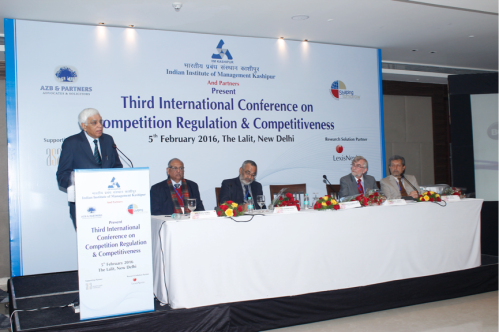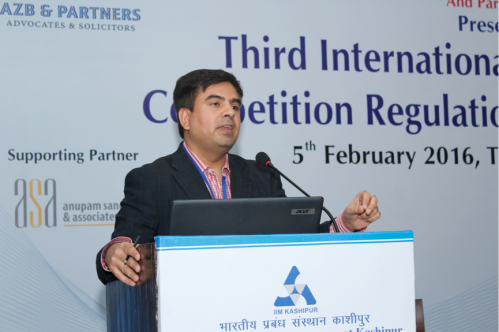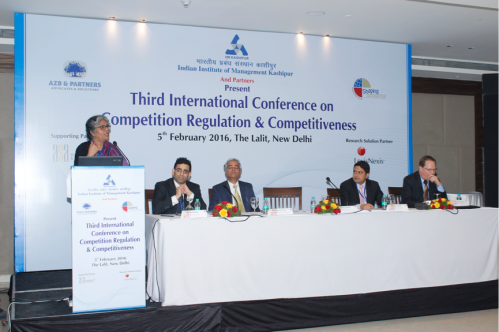The new Chairman of the Competition Commission of India, Devender Kumar Sikri, inaugurated an International Conference on Competition Regulation and Competitiveness on February 5, 2016, at Hotel Lalit, New Delhi. The event was organized by the Indian Institute of Management (IIM) Kashipur, India, alongwith AZB Partners, a leading law firm; Shaping Tomorrow, futuristic think-cum-action tank and ASA, a law firm with expertise in Competition, Commercial, Regulatory Law and Risk Mitigating solutions & LexisNexis, a leading global provider of content and technology solutions.
The Conference attracted some of the top-most global experts in the field of competition regulation, like William Kovacic & Frederic Jenny, apart from the representatives of OECD, FTC & some foreign law firms, and also competition agencies from other jurisdictions like Sweden, Turkey and Egypt. Eminent Indian law firms and corporates were also active participants and delegates for the Conference. The conference aimed to build and provide a global networking and interaction platform to understand and examine recent developments and prospects of competition regulation in India; to create a knowledge base to assist the decision-makers in different domains like government, regulators and corporates; and to identify actionable agenda for companies, market participants and policy makers. Here are the key points highlighted in each session.
Panel discussion on Overview of Competition Regulation in India
Increasing regulatory enforcement combined with increasing business complexity are posing large-scale legal and business risk. Corporate counsel are under mounting pressure to define the business risk along with the legal.

Mr. Gautam Sinha (Director, IIM Kashipur) said –
Competition is an interdisciplinary field and should be an integral part of business education.
India cannot take its national prosperity for granted; competitive advantage should be seized.
Focus should be there on renewability, innovation, and long-term value creation, among other things.This is in light of ‘Make in India, Start-up India, Skill India’.
 Mr. Anurag Goel (Founder, Shaping Tomorrow and Former Member, CCI) said –
Mr. Anurag Goel (Founder, Shaping Tomorrow and Former Member, CCI) said –
The concept of Disruptive Innovation needs to be understood in light of the fact that how competition regulators behave would change in changed context. Virtual platform does not recognize borders; has its own crypto-currency i.e. bit-coins, and future is going to be about e-platforms.
 Mr. Frederic Jenny (Chairman, OECD Competition Law and Policy Committee), Mr. Ajay Bahl (Partner, AZB and Partners) said –
Mr. Frederic Jenny (Chairman, OECD Competition Law and Policy Committee), Mr. Ajay Bahl (Partner, AZB and Partners) said –
In any new area of law, there exists, a certain degree of tension between the regulator and the regulated
India has a open trade-policy, complementary to competition. Being the 7th largest economy in the world, the size and contribution of its economy to international trade cannot be overlooked.
A sound legal environment to protect investments acts like fuel of trucks; and to make such fuel effective, a business-friendly environment is desirable.
Like organization of traffic, enabling policies act as facilitator to make a difference to the competition law-scenario in India, as competition law-enforcement is not a stand-alone policy.
 Mr. D.K. Sikri (Chairperson, Competition Commission of India) said –
Mr. D.K. Sikri (Chairperson, Competition Commission of India) said –
Stimulating economic growth is one of the major challenges that our country is facing at present. In light of this, structural constraints should be properly addressed, and the competitive process should move in tandem…
It has been witnessed that existence of liberalized markets cannot guarantee competitiveness by itself. There can be disruptions. So, competition law should check and prevent the growth of anti-competitive practices and environment.
Panel discussion on Analyzing and Regulating High-tech Markets and Markets of Tomorrow: Need for New Tools?
Competition laws were always applied to new businesses replacing old, however, today they are applied to a new platform as we move from ‘brick and mortar to a ‘cloud’ based internet platform. With a great mix on the panel, we heard lots of different dimensions / different perspectives / different solutions – on the new digital economy.
 Ms. Anupam Sanghi, Moderator (Managing Partner, ASA) said –
Ms. Anupam Sanghi, Moderator (Managing Partner, ASA) said –
Competitiveness will lead to immense value in business.This is especially true in light of PM Modi’s ‘IT (India’s Talent) + IT (Information Technology) = IT (India Tomorrow). 550 companies moved out of Forbes 2000 list due to digital disruption.
Its important for stakeholder’s to know how to deal with the sudden abundance due to the Internet & network industries – A key network industry is telecommunications, providing voice and data services, including the Internet.
what is so unique about the digital economy? How do network effect operates? Often, the more the consumers, the greater the overall value of the network and the lower the marginal cost of production.
And More Questions were discussed amongst the panelist

Mr.Mahesh Uppal, Technology Consultant, Director, ComFirst (India) Pvt. Ltd. said-
In today’s time, information economy is the real economy. The role of IT in development has been recognized for more than 3-4 decades now. Contemporary issues related to data markets, access to voice-over Internet services like Google voice, Skype, etc. need attention, especially in the context of network-neutrality. Competition issues related to the subject of free basics, net-neutrality, etc. are important. For eg.,the question of power that network-operators have on the content traveling on their network, in light of the fact that there’s no paid prioritization.
 Mr. John Davies (Head of Competition Division, OECD) said –
Mr. John Davies (Head of Competition Division, OECD) said –
The theme of this session provokes us to think about better usage of new tools for analyzing and regulating high-tech markets – If we take the example of the gaming industry, it’s a two-sided market with benefits for both, the game-user and game-developer. In such settings, how does one assess predatory pricing?
Also, concerns need to be handled based on short-term versus long-term benefits etc.
Competitive pressure comes not from the market, but from the waves of innovation. None of these features/problems are unique to high-technology markets.
Competition-policies are neither unidimensional nor exclusive to any one market. So, we need to reflect- Do we need new tools?
I would like to conclude by answering – We need new principles.

Ashish Chandra Group General Counsel (Snapdeal) said –
It needs to be seen whether we are talking about disruptive innovation, or anti-competitiveness. It’s noteworthy that the former breaks anti-competitiveness of existing players/markets. Technological progress in India (from say, 1970s to 2016) may be seen by taking the example of 3 industries-
(i) Communication (change from India Post to analog to digital modes)
(ii) Entertainment (change from AIR on radio to DD National on TV to satellite TV)
(iii) Retail (change from neighborhood stores to local shopping-complex to fancy DLF mall to online shopping-services)It’s not for new economy people to co-exist with old economy people, but the other way round.
I would suggest that firstly, instead of spending exorbitant amounts of money on celebrity-endorsement of brands for their publicity and promotion, simple schemes of incentivizing prospective customers may be used. Secondly, real business models need to be dissected to interpret laws and policies.
Panel discussion on Jurisprudence Development (Anti-competitive Agreements): Issues and Implications
Key issues which have come up for consideration before the Commission were deliberated on, like the scope of investigations by Director General – CCI, procedural requirements (principles of natural justice), parameters of imposing penalty, per se and rule of reason approaches, price parallelism and plus factors, bid rigging cases and issues of corruption versus anti-competitive agreement between bidders, etc.

Some relevant points made by the panel were –
Dr. Seema Gaur, Economic Adviser (Office of EA, DIPP) said – Complying with the principles of natural justice along with the need for expeditious redressal is a challenge to be met by CCI. Also, as there are no objective criteria for imposition of penalties, there’s a growing need felt for CCI to develop guidelines for the same.
Mr. Pradeep Mehta, Secretary General, CUTS International) said – In vertical agreement-related cases, investigation is guided by the theory of harm, i.e. how the conduct in question would be affecting competition and consumers in the market
Marc Reysen, co-founder, Reysen Competition Advice &Advocacy said – Cartels in USA are dealt with far more severely than in European Union. Administrative enforcement-system in the latter is not very different from that in India.
Ms. Osen Bergqvist, Deputy Head of Abuse and Vertical Restraints Unit, Swedish Competition Authority said- Why should a compliance-program that hasn’t worked, be rewarded? The vital question to be determined is that what kind of behavior do we want to encourage or discourage by way of imposition of fine.
Panel discussion on Jurisprudence (Abuse of Dominance): Issues & Implications
Several issues beginning from the definition of relevant market, requirement and emphasis on market shares for determining dominance, lock-in of customers and abuse, predatory pricing cases, determination of cost factor, dominance of trade associations, dominance of public sector units in some markets and competitive neutrality were highlighted. Impact of CCI/COMPAT orders on markets, firms and competitiveness were also discussed.

Dr. Geeta Gouri, Former Member said – It’s wouldn’t be incorrect to remark that CCI is unduly dominated by the legal-approach. Economic evidence would mean spending a considerable amount of money.
Mr. Sameer Gandhi, Partner, AZB said – It may be concluded that market-share is not a determinative measure, in our country or globally, but it’s definitely a starting point.
Ramji Srinivasan, Senior Advocate, Supreme Court of India, said- It’s common that process and procedures are breached quite regularly by the CCI; but what is of real significance is that the means to an end should be clear, fair, etc.
Mr. Ruchit Patel, Partner, Ropes & Gray UK, said – In Europe, however, the understanding is that since shares themselves are imperfect, it’s considered to be imperfect parameter of market-power.
Mr. Nicholas Franczyk, Federal Trade Commission, USA said – There’s a natural tendency and temptation to gravitate towards giving importance to market-share, as these are ‘numbers’.But using these as an absolute measure for determining dominance is not recommended.